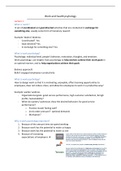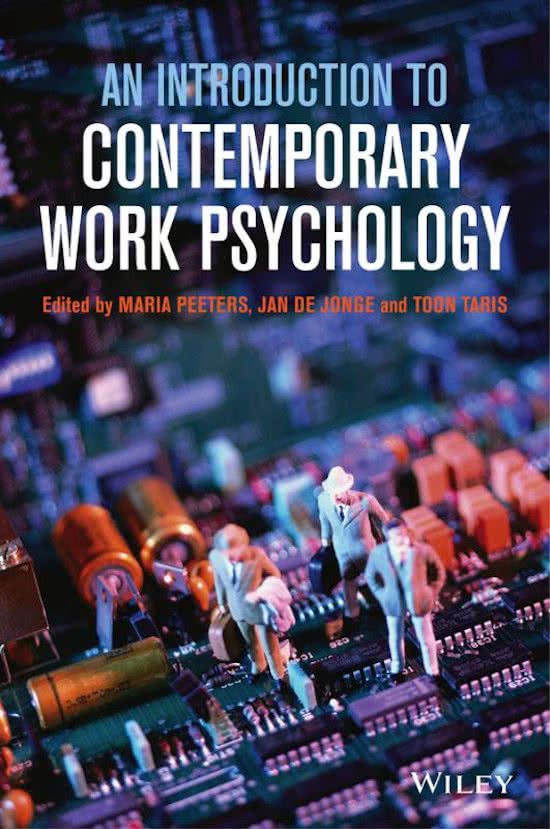Work and health psyhology
Lecture 1
What is ‘work’?
‘A set of coordinated and goal-directed activities that are conducted in exchange for
something else, usually some form of monetary reward’.
Example: Waiter/ Waitress
- Coordinated? Yes
- Goal-directed? Yes
- In exchange for something else? Yes
What is work psychology?
Psychology: individual level, people’s behavior, motivation, thoughts, and emotions
Work psychology: use insights from psychology to help workers achieve their work-goals in
an optimal manner, and to help organizations achieve their goals
Balance approach!
Belief: engaged employees= productivity
What is work psychology?
How to design work so that it is motivating, enjoyable, offers learning opportunities to
employees, does not induce stress, and allow the employees to work in a productive way?
Example: waiter/ waitress
- Organizational goals: good service performance, high customer satisfaction, & high
profits. Sustainability?
- When do waiters/ waitresses show the desired behaviors for good service
performance?
o Positive mood/ feeling well?
o (not) under pressure?- optional demands
o Motivation?
Why is work psychology important?
1. Because of the amount time we spend working
2. Because work has the potential to make us happy
3. Because work has the potential to make us sick
4. Because of increasing
expectations of employers →
,Course positioning
- S(HRM) is mainly focused at the organizational/ group level. It often deals with the
workforce/ the anonymous worker in an organization rather than with the worker as
a person. In addition, it is very much focused on strategies and practices that
ultimately benefit the organization.
➔ Kernvragen PEW/ SHRM
- OB often has a tendency to emphasize the social aspects of behavior in organizations
(teams, leadership, relationship, conflict/ cohesive) rather than job/ task-related
aspects
➔ OB/ Managing social capital
- This course, WHP, deals with the individual worker and his/ her work, well-being, and
performance. It mainly deals with literature in the area of work psychology and
occupational health psychology
The roots of work psychology
When did it start? And why?
Pre-industrial/ agrarian → industrial revolution
Psychotechnics/ applied psychology
Psychotechnics= the practical or technological application of psychology, as in analysis of social or
economic problems.
(…) the psychological experiment is systematically to be place at the service of commerce and industry
(Münstererg, 1913)
Pioneers:
- Jean Marie Lahy (France, from 1903 onwards)
o Experiments on the selection of streetcar operators
o General method for employee selection (normed tests)
- Münsterberg (Germany/ U.S., 1913)
o ‘’Selection of those personalities which by their mental qualities are especially
fit for a particular kind of economic work.’’
o Work on the selection of drivers, typists, army gunners, etc.
Scientific management
Country of origin: USA
Founding father: Frederick Winslow Taylor
‘’As to the importance of obtaining the maximum output of each man and each machine, it is
only through the adoption of modern scientific management that this great problem can be
finally solved’’ (Taylor, 1911)
(not focusing on the match between worker and task, but mostly on the task)
➔ Focus on the task (simplification of tasks)
➔ Why?
➔ Two assumptions about the workers
,First assumption of Taylor approach→ workers are lazy
‘’… in nineteen out of twenty industrial establishments, the workmen believe it to be directly
against their interests to give their employers the best initiative, and that instead of working
hard to do the largest possible amount of work and the best quality of work for their
employer, they deliberately work as slowly as they dare while they at the same time try to
make those over them believe that they are working fast.’’ (Taylor, 1939)
Second assumption of Taylor approach → workers are stupid
Pit iron handling (Raw iron bar)
Task: loading or piling pig iron (~46 kg)
‘’There is a science of handling pir iron, and (…) this science amounts to so much that the
man who is suited to handle pig iron cannot possibly understand it, nor even work in
accordance with the laws of this science, without the help of those who are over him’’
(Taylor, 1911)
Scientific management: Solution
To maximize productivity:
- Simplify tasks as much as possible
- Examine the best way to conduct the tasks
- Training workers in the one best way to conduct the tasks (High control)
- Separating the planning of tasks from their execution
- Selecting workers for particular tasks (E.g., greedy worker)
Hawthorne studies (1924-1932)
Researchers: National Research Council, Fritz Roethlisberger, Lloyd Warner, & Elton Mayo
1. Effects of lightning intensity on productivity
2. Relay assembly Test Room
o 5 women in a secluded room
o 13 experimental manipulations
nd
3. 2 Relay Assembly Test
o Incentive schemes (team-based)
4. Mica Splitting Test Room
o Incentive schemes (team-based)
5. Interviews
o Importance of empathic listening and participation
6. Bank Wiring Observation Room
o 14 workers
o Informal system and group norms
, Human relations movement
‘’From the time of the publication of the results of the Hawthorne Studies onward, no one
interested in the behavior of employees could consider them as isolated individuals, rather,
such factors and concepts as group influences, social status, informal communication, roles
norms, and the like were drawn upon to explain and interpret the voluminous data from
these studies and other field investigations that followed them.’’
Contemporary work psychology
1. Well-being: ‘’The state of being comfortable, healthy or happy’’ (Oxford dictionaries)
‘’Health is a state of complete physical, mental and social well-being and not merely
the absence of disease or infirmity.’’(WHO)
2. Well-being at work:
- Health (physical well-being)
o Decrease disease and injuries, stress, and increase benefits
- Relationships (social well-being)
o Increase trust, support, decrease exploitation, and power abuse
- Happiness (psychological well-being)
o Increase pleasure, satisfaction and fulfillment/ engagement, and decrease the
opposite thereof
3. Performance: ‘’The action or process of performing a task or function
Work performance: action or outcome?
Action: ‘’Performance is what the organization hires one to do, and do well’’
Outcome: ‘’The consequence or the result of the individual worker’s behavior’’
NB: the book takes a behavioral view on performance, that is, performance as actions
4. Dimensions of individual job performance:
- Task performance (proficiency)
- Organizational citizenship behaviors (OCB; going the extra mile)
- Counterproductive work behaviors
- Employee withdrawal behaviors
Lecture 2
We all make use of theory (constantly).
Theory helps us to make sense of the complex world around us
Theory captures the knowledge base in a certain field
Theory has a normative value: It is not just about how the world as it is, but also as it might
be.
Design
What is design?
a) The art or action of producing a plan or drawing of something before it is made
b) Purpose or planning that exists behind an action, fact or object





